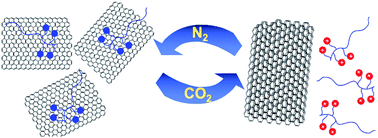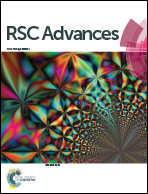Smart graphene dispersion stabilized by a CO2-removable polymer†
Abstract
Polymeric dispersants play a pivotal role in improving graphene solubility in common solvents; however, the presence of such a foreign dispersant may exert a negative influence on the intrinsic properties of graphene. Thus, it is particularly important and challenging to remove the dispersant when graphene is used in end applications. Here, we report a smart graphene dispersion by a CO2-triggered removable diblock polymer – poly(ethylene oxide)-b-poly(N-(3-((3-((4,6-bis((3-(dimethylamino)propyl)amino)-1,3,5-triazin-2-yl)amino)propyl)(methyl)amino)propyl)methacrylamide) (PEA). Using absorption spectroscopy, Raman spectroscopy, XPS spectroscopy and TGA measurements, it was found that PEA can not only strongly interact with graphene to form a stable, concentrated aqueous dispersion, but it can also be removed from the graphene surface upon CO2 treatment as the tertiary amino groups along the polymer chain can be protonated, thus diminishing the affinity for graphene. This study may offer a general strategy for the design of removable dispersants for nanomaterials.


 Please wait while we load your content...
Please wait while we load your content...